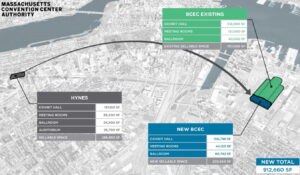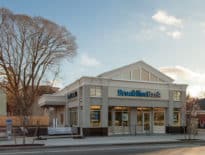Having secured their board’s approval for a plan to sell one Boston convention center and add to another, officials at the Massachusetts Convention Center Authority hope to have a request for proposals to find the teams that will design and construct the expansion of the Boston Convention and Exhibition Center out within the next 60 days.
The MCCA’s board of directors on Thursday took a series of votes to authorize the sale of the Hynes Convention Center, pending legislative approval, to begin work towards a $500 million expansion of the BCEC and to return 12 acres of land in the seaport to the city of Boston.
The plan, first announced Monday by Gov. Charlie Baker’s budget office, is intended to attract more and larger conventions to Boston, enhance economic activity in both Boston neighborhoods – Back Bay and the Seaport – and open up the possibility of the redevelopment of the potentially desirable Hynes location. While one air rights project over the Mass. Pike in Back Bay was recently approved by the Boston Planning and Development Agency another developer recently walked away from plans to build an air rights condominium tower next door at 1000 Boylston St.
MCCA Executive Director David Gibbons said one of the votes authorized him to accept the recommendation of architectural firm Populous, which has been engaged in the BCEC’s master planning process for almost two years, to build an extension with 100,000 square feet of exhibition hall space, a 60,500-square-foot ballroom and 44,000 square feet of meeting rooms.
The next step is for the MCCA to issue an RFP and then select firms to design and build the new wing of the BCEC. Gibbons said he expects to issue that RFP within 60 days.
The Baker administration’s plan seeks the addition of roughly 500,000 square feet of new space, 204,500 square feet of which would be “sellable space” for conventions and exhibits while the rest would be back of house areas, hallways and more.
With the expanded capacity and a greater variety of room types available, the BCEC “will be positioned to capture greater market share for large multi-day conventions and shows and accommodate bookings that might otherwise have gone to the Hynes,” the administration said.
Gibbons said the board voted Thursday to cap the project’s cost at $500 million and that much of the BCEC expansion will be financed with proceeds from the sale of the Hynes. To make up the difference between the price the Hynes fetches and the final BCEC expansion price tag, the administration plans to use pay-as-you-go capital funds from the state’s Convention Center Fund.
“You know, I’m not sure if it will cover all of it,” Gibbons said about the profits from the Hynes sale covering the full cost of the BCEC addition. “I think it will cover a whole lot of it, but I don’t think it quite covers all of it. It depends on how competitive the bidding gets.”
The MCCA plans to hire a real estate brokerage to market the Hynes and promote it on the market. Even though the sale of the Hynes requires approval from the legislature, Gibbons said the MCCA will start conversations with brokers as lawmakers begin to review the proposal so the plan can be put in motion as soon as the Legislature grants its approval.
“We’re not going to sit and wait for the legislature and then start the clock,” he said. “Hopefully they will move quickly, but that’s not for me to say.”
Not only will the sale of the Hynes help fund the BCEC expansion, but it will also allow the state to avoid millions in ongoing maintenance and upkeep the Hynes is expected to need. The Hynes, which opened in 1963 and was rebuilt in 1988, needs “major capital investments” estimated at nearly $200 million over the next 10 years just to maintain its current state,” the administration said.
Gibbons said a recent study came up with $400 million worth of ideas to modernize the Hynes and make it more cosmetically appealing, but nothing could be done to make the space larger.
“You could spend $600 million and 10 years from now you’d have the same dysfunctional Hynes but it would look prettier and the heat would work,” he said. “It’s an old building and it’s at end of life … it has been well-maintained by the state but at a certain point buildings have a cutoff point.”
Another factor that weighed against keeping the Hynes, Gibbons said, is the plan for a number of significant construction projects near the Back Bay site in the next three years, making it difficult for exhibitors to get large trucks in and out of the Hynes loading zones.
“It’s being surrounded by current and future development to the point where it will soon be difficult if not impossible for us to operate the building,” Gibbons said, adding that some events at the Hynes require 50 to 60 trucks. “We’re reaching the point where there would be a period of time as Boston develops to our west that, sooner or later, we’re landlocked.”







